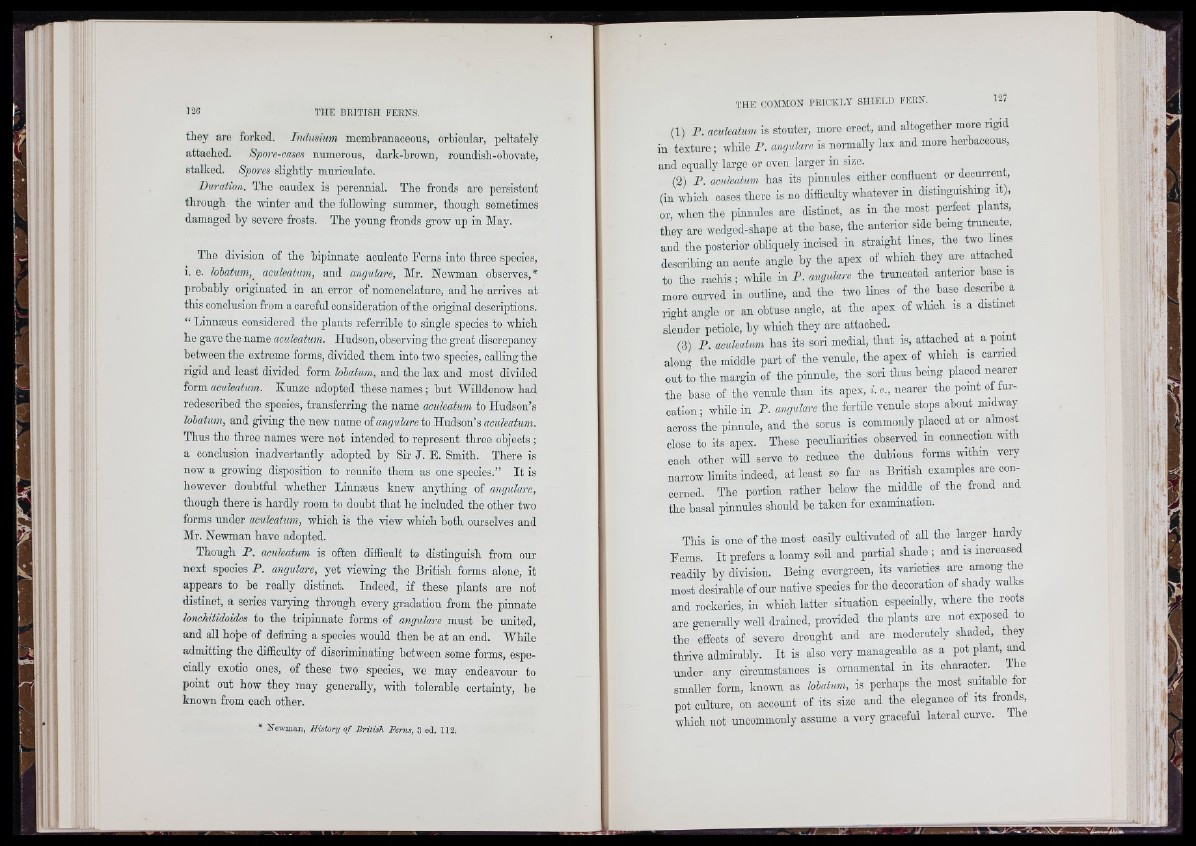
they are forked. Imlmium membranaceous, orbicular, peltately
attached. Spore-cascs numerous, dark-brown, roundish-obovate,
stalked. Spores slightly muriculate.
Duration. The caudox is perennial. The fronds are persistent
through the winter and the following summer, though sometimes
damaged by severe frosts. The young fronds grow up in May.
Tho division of the bipinnate aculeate Ferns into three species,
i. e. hbatum, aculeatum, and angulare, Mr. Newman observes,*
probably originated in an error of nomenclature, and he arrives at
this conclusion from a careful consideration of the original dosorijitions.
“ Linnæus considered the plants referrible to single species to which
he gave the name aculeatum. Hudson, observing the great discrepancy
between the extreme forms, divided them into two species, calling the
rigid and least divided form lohatum, and tho lax and most divided
form aculeatum. Kunze adopted these names ; but Willdenow had
redescribed the species, transferring the name aculeatum to Hudson’s
lobatum, and giving the new name oi angulare io Hudson’s aculeatum.
Thus the three names were not intended to represent three objects ;
a conclusion inadvertantly adopted by Sir J. F. Smith. There is
now a growing disposition to rcunito thorn as ono species.” I t is
however doubtful whether Linnæus knew anything of angulare,
though there is hardly room to doubt that he included tho other two
forms under aculeatum, which is the view which both ourselves and
Mr. Newman have adopted.
Though P . aculeatum is often difficult to distinguish from our
next species P . angulare, yet viewing the British forms alone, it
appears to he really distinct. Indeed, if these plants are not
distmot, a series varjdng through every gradation from the pinnate
hnchitidoides to the tripinnate fom s of angulare must be united,
and all hope of defining a species would then be at an end. While
admitting the difficulty of discriminating between some forms, especially
exotic ones, of these two species, we may endeavour to
point out how they may generally, with tolerable certainty, he
knouTi from each other.
‘ Newman, History o f British Perns, .3 ed. 112.
(1) P . aculeatum is stouter, more erect, and altogether more rigid
iu tex tu re ; while P . angulare is normally lax and more herbaceous,
and equally large or ovon larger in size.
(2) P . aculeatum has its pinnules either confluent or decurren ,
(in which oases there is no difficulty whatever in distinguishing it),
or, when the pinnules are distinct, as iu the most perfect plants,
they are wedged-shapo at the base, the anterior side being truncate,
and the posterior obliquely incised in straight lines, the two hues
describing an acute angle by the apex of which they are attached
to the rachis; while in P . angulare the truncated anterior base is
more curved in outline, and tbe two lines of the base dosonbe a
right angle or an obtuse angle, at tbe apex of wHob is a distmct
slender petiole, by which they aro attached. ^ ^
(3) P . aculeatum has its sori medial, that is, attached at a pom
along the middle part of the venule, the apex of which is carried
out to the margin of the pinnule, the sori thus being placed nearer
tho base of the venule than its apex, i. c., nearer the point ot tur-
catioii; while in P . angulare the fertile venule stops about midway
across the piimule, and the sorus is commonly placed at or almost
close to its apex. These peculiarities observed m connection with
each other will serve to reduce the dubious forms within very
narrow limits indeed, at least so far as British examples are concerned.
The portion rather below the middle of the frond and
the basal pinnules should he taken for examination.
This is ono of the most easily cultivated of all the larger hardy
Ferns. I t prefers a loamy soil and partial shade ; and is increased
readily hy division. Being evergreen, its varieties are among the
most desirable of our native species for the decoration of shady walks
and rockeries, in which latter situation especially, where the roots
aro generally well drained, provided the plants are not exposed to
the effects of severe drought and are moderately shaded, they
thrive admirably. I t is also very manageable as a pot plant, and
under any circumstances is ornamental in its character. The
smaller form, known as lohatum, is perhaps the most suitable for
pot culture, on acoouut of its size and the elegance of its fronds,
which not uncommonly assume a very graceful lateral curve, ib e
. 1
16
mm